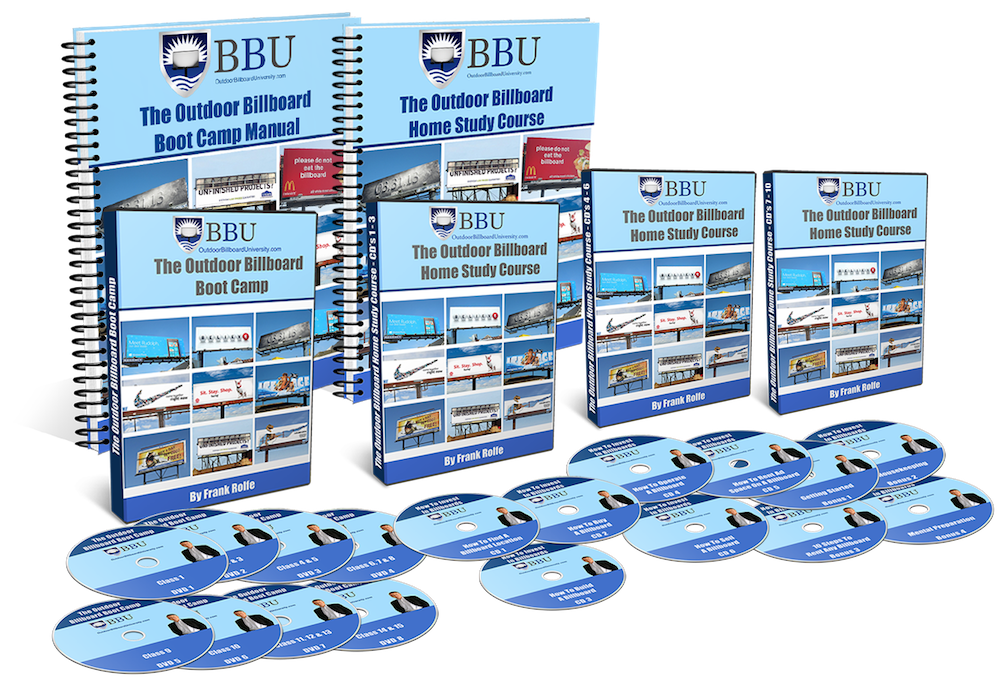Memo From Frank
I was recently in Los Angeles, where I used to own a portfolio of billboards. It was a very unusual transaction, as described in the story below. But it was also a great opportunity to learn the sign business in a second major market. Having built a large portfolio in Dallas/Ft. Worth, Texas, it was a challenge to do it again in Los Angeles. But it was much easier the second time around. One of the great strengths of the billboard business is that – like riding a bicycle – once you’ve learned it once, it’s yours for life. The business model of billboard advertising is highly transferable to the many segments of “out-of-home” advertising, which includes everything from billboards to airport advertising. That’s why the industry is so adaptable to so many different markets and products, and can be custom tailored to your situation, regardless of what or where it is.
How I Came To Own This Sign For Free – And 25 Others Like It
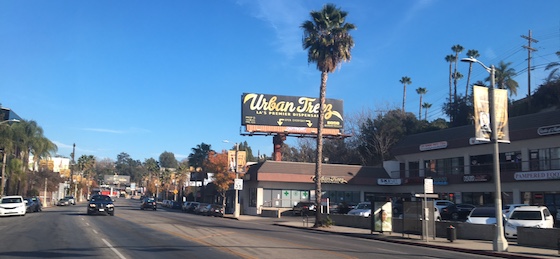
I have always been somebody who is fascinated with buying something that is broken for a penny on the dollar and then trying to fix it. I believe that buying broken things cheap offers a huge potential payday, and mitigates a huge amount of risk. But the billboard company I bought in Los Angeles takes this to an extreme, and is a textbook example of exactly how you should try to structure these type of deals.
Look for opportunities to buy abandoned signs
I had become obsessed with buying abandoned billboards after I purchased one for $1,000 on Highway 75 in Dallas, put another $1,500 into it, and rented it for a net profit of $20,000 per year. After that, I was constantly seeing abandoned signs along the highway, and contacting the property owner to see if I could buy it and bring it back to life. I called on every abandoned sign Ii encountered in probably a three-state radius. As I racked up more of these deals, the word got around that I was always a player for these opportunities.
Be a “deal-maker” and not a “deal killer”
One day I received a call from a billboard appraiser who worked on projects across the U.S. He had heard that I was really into abandoned signs, and wanted me to know that there was an entire abandoned billboard company in Los Angeles. Roughly 29 steel signs were literally all blank and left to rot by the owner. He had a tip on the name of this person, and I ultimately got a hold of their home phone number. The back story was that the person’s brother had died in a car wreck – he was the one who built the signs – and this person then inherited them. Knowing nothing of the industry, they simply left them untouched for years. Would they sell? Sure, at the right price. We bounced around numbers and they agreed to a price of around $300,000 and gave me one year of due diligence to figure it all out before closing. While this deal would have clearly scared most people off, I like to be a “deal maker” and not a “deal killer” – and this deal would need a lot of creative thought to patch it all together.
Trust your instincts
From the beginning, my gut instinct was that this deal should be purchased, if at all possible. How often do you find a big pile of abandoned signs in one market, particularly a market like Los Angeles. Plus, these signs were all steel monopole, and not the wooden telephone-pole units I was used to. Even though everyone else told me it was a crazy concept, I continued to try to reach out to the landowners and get new leases signed and permits reactivated during my due diligence period. I had to trust my instincts on this deal, as nobody else supported it.
Look for opportunities to hedge your risk
Here’s where my big breakthrough came into play. Just as a sanity check, I decided to go to a giant billboard company in Los Angeles and see if they might want to buy a few of these billboards it I was able to bring them back to life. They looked through the pile and said, yes, we’d buy these three at the right price. It was two billboards at the entrance to Universal Studio, and one in Pasadena. The price we agreed to was the same amount I was paying for the entire company. That means that if I could pull this deal off, I’d own all the signs free and clear, and not even have to get a loan to complete the transaction. I went into my discussions with the big company hoping for some assurance of the signs’ values and came out with an epic offer. If only I could put it all together...
Recognize your big break and don’t let go of it
I knew that this was a huge break – a once-in-a-lifetime deal. There was no way I was going to let this thing go. So even though I had a huge number of roadblocks and cliffhangers, I was persistent and would not let the deal die. I begged people so sign my lease. I called people 10 times a day to try and meet them to sign my lease. I called the city inspector 500 times to get my permits. A year after beginning the crazy adventure, I was at a title company, and by the end of the day I owned all the signs free and clear, except the three I had sold to the big company.
Conclusion
Just one deal like this can change your life. So what was were the big lessons learned? To look for opportunities to buy things cheap. To trust your instincts and not listen to those that would stifle your dreams. Be persistent and always try to mitigate your risk. And when you see that big opportunity, go for it.
The Ultimate Billboard Boot Camp
![]() How to Find a Billboard Location
How to Find a Billboard Location
![]() How to Buy a Billboard
How to Buy a Billboard
![]() How to Build a Billboard
How to Build a Billboard
![]() How to Operate a Billboard
How to Operate a Billboard
![]() How to Rent Ad Space on a Billboard
How to Rent Ad Space on a Billboard
![]() How to Sell a Billboard
How to Sell a Billboard
Get Your Copy Now!
The Top Seven Ways To Grab Attention With A Billboard
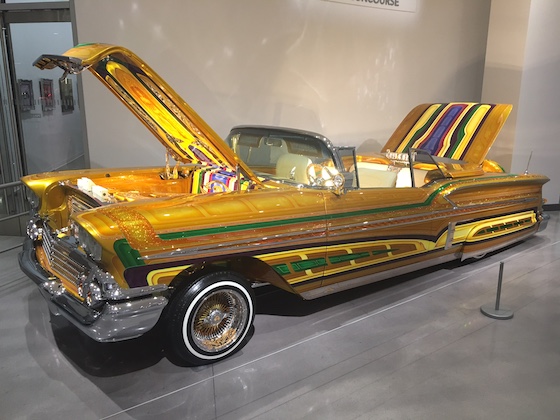
So you’re trying to help that advertiser put up some highly effective copy on your billboard. What are the top seven ways to grab attention? The good news is that this question has been studied and refined since the 1930s. Here is the finding of that scientific study.
Colors
The best colors for billboards are the exact opposite of “earth tones” and colors you see in nature. To contrast that green expanse of trees, you want the opposite color, which is red. That’s why so many huge chains have red signs: McDonalds, Wendy’s, Chik-Fil-A, Exxon and 100 others. It was no accident or coincidence. Never use a color on a billboard that comes from nature. And also use a huge amount of contrast between the words and the background color. Light letters should be on a dark background, ad vice-versa.
Big words
Words on billboards should be gigantic – typically at least 3’ in height. To accomplish this, you have to use only a very few words in your design. The general rule is to shoot for 3 to 5 total words. With that few words, you can use really big letters. And that’s essential.
Use of great pictorials
One terrific way to garner attention with a billboard is to take advantage of the vinyl printing technology, which began in the 1990s. Since all billboards are now printed – and not painted by hand – you can put up giant, colorful photos that really have appeal. The best billboards today have both great copy as well as graphics – probably 50% of the ad space is devoted to the photo.
Extensions
These are pieces of the billboard that extend beyond the rectangular boundaries, typically at the top of the sign. It can be a piece of the photo (like a steeple or the head of a person) or a piece of a letter of the copy (like the capital letter on the start of the verbiage). Regardless, it catches the eye of the viewer because it “breaks the line” of the box and makes you want to look at it.
Sequins
While you don’t see these as much today, there is a product called Solaray that allows you to make billboards shimmer in the light. They are like giant sequins that you find on a dress, only 100 times larger. They are very low-tech, and never break. In the right application, they have a huge amount of bang for the buck.
Motion
While this is the most complicated and expensive way to get attention on any billboard, it’s worthy of mention since so few advertisers even think about it today. The “motion movement” began in the 1930s, and included such effects as a man waving to the motorists, or a pot pouring coffee into a cup. Some motion was simply steam coming off a hot tub, which was created using a simple heater and a pipe above the billboard. Get creative but also get realistic, as these type of features are not cheap.
Changing sections
I’m not talking about tri-vision or LED here. I’m talking about sections of the advertisement that change out periodically to showcase upcoming events. For example, if you have an advertiser that does frequent performances, an area where you can put the upcoming act and date. Or maybe it’s a section for a used car dealer that he puts his latest hot deal or special. This helps make the sign a stronger salesman for the client.
Conclusion
It’s vital that all good billboard advertisements grab attention. These are some of the top ways to create that sense of excitement, and a successful sign always gets renewed, so it’s definitely worth the effort.
Why You Should Never Put Too Much Effort Into Your Shield
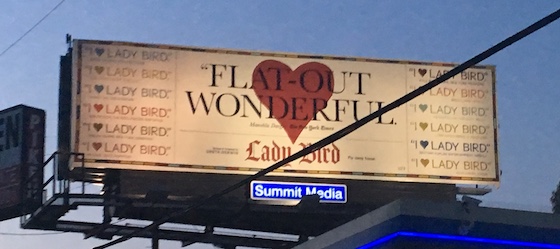
A “shield” is a name or logo that is placed on a billboard, to identify its ownership. It is traditionally located centered in the skirting underneath the advertisement. They come in all shapes and colors, but occasionally sign owners can take this ego item a bit too far. So here are some things to think about before putting your “shield” on a sign.
Should not distract from the advertisement
The whole point of the “shield” is to identify ownership and possibly build brand awareness. But it should be subtle and no distracting. In Los Angeles, for example, it is not uncommon for the sign owner to put an internally-illuminated “shield” on a sign. However, when the “shield” shines brightly at night – and the advertisement not as much – the “shield” is a significant distraction. The same is true of “shields” that are too big or too brightly colored.
Should be reasonably priced
While a “shield” is a great ego boost for the sign owner, it is not that big a value add. Most advertisers want to rent a specific sign for the reasons of location and visibility, and could care less who owns it. So having your logo on it does not really make you any money. The only reason they first put “shields” on billboards was so that billboard company employees knew they were on the right sign (notice that the larger companies put serial numbers next to the shield). So don’t spend a ton of money on them. A good choice is to have it silkscreened on a piece of sheet metal. That’s all.
Should be reasonably sized
So if the “shield” should not be too distracting nor too expensive, then how big should it be? A good rule of thumb is 18” or so high, and around 6’ to 8’ long. This is half the width of the skirting, and around 15% of the total length of a standard sign. That’s plenty big enough to read.
Conclusion
Every billboard should have a “shield” on it. It’s a source of pride for the owner and a good identification tool for advertisers and workmen. But as important as it is to have one on there, it’s important that it be a productive part of the sign, and not a detriment. These tips should keep you out of trouble.
Landmark Billboards: The Holy Grail Of Signage
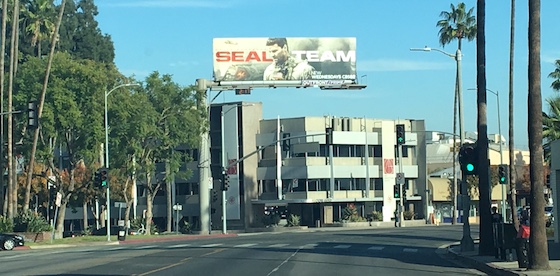
Some billboards are a cut above the rest. These are the most cherished and valuable of outdoor signage, and you should always watch for these opportunities. The best billboards include one or more of the following items:
- Curve-in-the-road visibility. The sign hangs directly in your face while you’re driving.
- An incredible background to the sign, such as a view of downtown or a mountain range.
- The effective use of a large “V” to angle the sign directly into the viewer.
- Placement above any obstructions, so you can see the sign from miles away.
When you see billboards like this – or opportunities to build them – you should make every effort to do so. These kind of signs command the highest rents and have near perfect retention and renewal.
